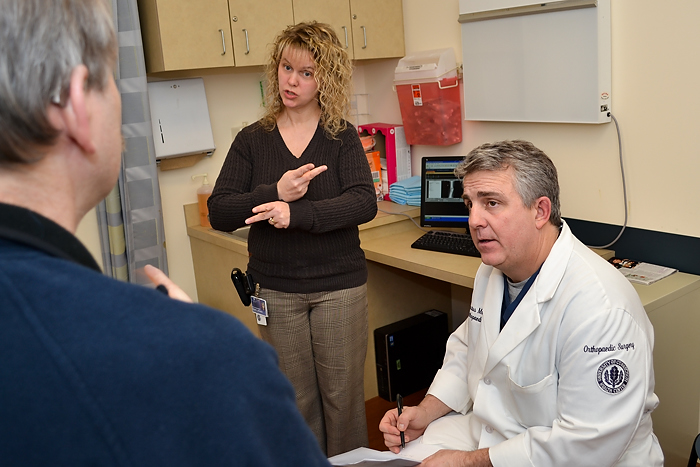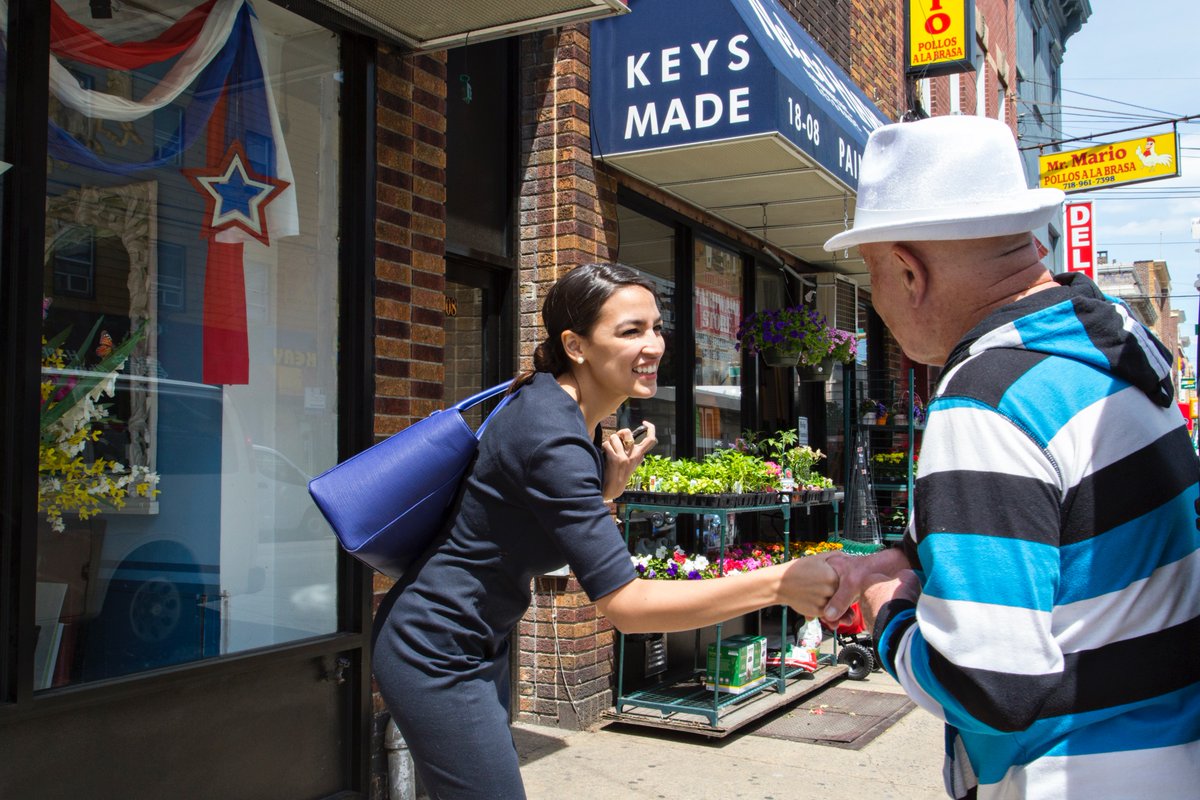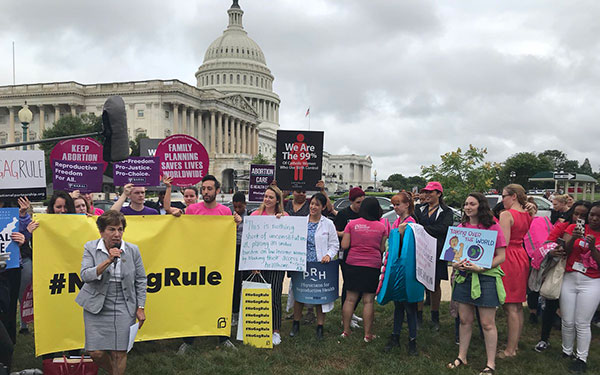28 Years Later, ADA Non-Compliance Leaves Deaf Patients At Risk

(photo via UCONN)
Imagine being in so much pain that you call 911. Imagine being transported a great distance by an ambulance, all the while in excruciating pain and scared about what might be going on inside your body. Imagine that when you arrive in the hospital, multiple people poke and prod you without telling you what they are doing and without your being able to tell them what you need.
All too frequently, this is the experience of people who are deaf within the United States medical system, because of a complete disregard for the regulations and guidelines set forth in the Americans with Disabilities Act (ADA), which mandate sign language interpreter services.
When former President George H. W. Bush signed the ADA 28 years ago last week, he said, “Let the shameful wall of exclusion finally come tumbling down.” The ADA requires systemic change in how America accommodates people with disabilities, yet more than a quarter of a century after the law’s enactment, pervasive “walls of exclusion” still exist.
New York Lawyers for the Public Interest (NYLPI) recently settled a complaint on behalf of a deaf person in New York City who was denied access to interpreter services at a hospital. It took over six years to resolve the matter, and the client continued to encounter countless similar experiences virtually every time she attempted to schedule an appointment with and visit a medical professional.
This individual is not alone – primary care doctors, specialists, dentists, mental health providers, nursing homes, rehabilitation facilities, and labs routinely deny interpreter services to people who are deaf. This systemic discrimination in the health care setting is illegal under the ADA and has been illegal for even longer in places like New York City, where there are strong state and city non-discrimination laws at play.
The lack of effective communication access is not unique to New York City. The Syracuse University College of Law Disability Rights Clinic also regularly litigates cases of healthcare providers refusing to offer sign language interpreters in upstate New York.
Although there are resources available in New York to hold medical professionals and other agencies accountable if they do not provide effective communication, these problems remain. The New York City Commission on Human Rights and the New York State Division of Human Rights have the ability to investigate and redress such discrimination, even where the individual wants to proceed anonymously. However, these mechanisms are not enough to prevent countless instances of discrimination against members of the deaf community who seek health care.
So if it is illegal, and there are mechanisms for redress, why does the problem persist?
It’s all about money and attitude. There’s a pervasive disregard in the health care profession for the importance of effective communication access for both provider and patient. As an anti-discrimination law, the ADA was intended to enact societal change. However, laws are often not enough – we need a shift in culture.
When deaf individuals speak out about not receiving interpreter services at medical offices, they are often told it is too expensive and providers are reluctant to pay for communication access. The problem is even more acute for solo practitioners than it is for large hospitals and medical practices with deep pockets. The medical community’s failure to budget and plan for this easily anticipated and legally required expense is unacceptable.
Those who speak out are also told they do not really need an interpreter as they can communicate through other means. This is unacceptable.
To require a person who is deaf and deprived effective communication access to seek change, continue to advocate until the change is made, file a lawsuit if the change is not made, and continue to prosecute the lawsuit until it is resolved, is not a realistic solution for creating a more accessible world. It unfairly places the onus on the deaf individual.
There are already models for how to pay for these services. A few years ago, the Monroe County Bar Association established a fund to help defray up to 50 percent of a member’s interpreter bill. Likewise, Title IV of the ADA, which mandates the establishment of a national telephone relay system enabling deaf people to communicate, is funded through a tiny fee collected from everyone’s telephone bill. For health care providers not affiliated with a large institution, a similar fund should be created.
Access delayed is access denied for members of the deaf community when they seek health care. We need creative funding, changes in attitude, and adherence to the law immediately to address this abhorrent situation.
***
Michael Schwartz, Associate Professor of Law at the Syracuse University College of Law, Director of its Disability Rights Clinic, board member at Tangata Group, and a long-time deaf rights advocate; and Maureen Belluscio, Senior Staff Attorney, Disability Justice Program of New York Lawyers for the Public Interest. On Twitter @NYLPI.
***
Have an op-ed idea or submission for Gotham Gazette? Email This email address is being protected from spambots. You need JavaScript enabled to view it.
Key Takeaways from Ocasio-Cortez's Victory

Alexandria Ocasio-Cortez campaigning (photo: @Ocasio2018)
Alexandria Ocasio-Cortez’s victory seems to be misunderstood in a number of ways. First, it is hard to say that it was representative of Democratic Party supporters in the district. Suppose we measure the Democratic Party voters by Crowley’s vote total in the 2016 Congressional election, when he faced no primary opponent and a nominal general election foe (Crowley won 83 percent). The 2018 Democratic primary total -- 28,000 votes -- was only 19.0 percent of this amount.
Indeed, Ocasio-Cortez’s victory reflected the typical outcome of a restrictive voting system favored by the Democratic Party establishment because of its ability to turn out its patronage base. The decline of the patronage base has reduced the turnout of establishment-oriented Democrats while Bernie Sanders has shown the way for a progressive challenger to harness the internet and social media to turn out a base of followers. Thus, Ocasio-Cortez was able to turn the tables on the Democratic Party organization in a low turnout election.
Second, her margin over Crowley was 3,584 in the Queens precincts but only 542 in Bronx precincts. This suggests that her appeal was not primarily to the Latino working-class community but instead the Queens professional class. This thesis is further strengthened by looking at the voter turnout in each borough. In 2016, 66.0% of Crowley’s votes were from Queens whereas in the 2018 primary, 72.4% of the votes were from Queens. Again this is consistent with the Sanders movement.
Despite his principled commitment to working-class politics, Sanders’ message overwhelming resonated with the professional class and little with communities of color. Having a Latina candidate, however, was ideal given the district’s ethnic composition and the desire of Sanders’ supporters to demonstrate their commitment to both far-left politics and multiculturalism.
What happened in the 14th Congressional district certainly reflects the decline of the ability of centrist Democrats to appeal to the anti-Trump movement.
There is also a deeper dynamic at work. In the 1950s, fully one-third of all non-supervisory private-sector personnel were members of unions, giving the Democratic Party a pragmatic working-class base that led to centrist policies.
Similarly, the working class support enabled left-of-center parties in Western Europe and Israel to contest for power with pragmatic centrist policies. In and around 2000, Clinton (U.S.), Blair (U.K.), Schroeder (Germany), Jospin (France), and Barak (Israel) represented victories for this agenda. However, as traditional working-class jobs have declined, as union membership in the private sector has plummeted, this base has shrunk and so too has the support for centrist policies. In the U.K., this has caused a shift in the Labor Party to a much more leftist orientation and this is the direction the Democratic Party has moved in the U.S.; no longer centered around private sector workers but increasingly a party of the professional class and less affluent people of color.
Ocasio-Cortez’s victory crystallizes another important cleavage: the schism between an increasingly active anti-Israel stance among leftist Democrats and the pro-Israel stance of more centrist Democrats. The animus to Israel shown by Democratic Party leader Keith Ellison and candidate Bernie Sanders is amplified by her victory.
She is a member of the Democratic Socialists of America, which has as one of its platforms, support for the Boycott, Divest, and Sanction (BDS) movement. Not only has Ocasio-Cortez not rejected this part of the platform, she has enunciated extreme anti-Israel positions and not shown support for a two-state solution.
How will centrist pro-Israel Democrats deal with this increasingly aggressive anti-Israel stance? Senator Gillibrand, in her courting of the left flank, has embraced Ocasio-Cortez as she did Women’s March leaders who embrace the anti-Semite Louis Farrakhan. However, given his unequivocal support for Israel and rejection of BDS, what will Senator Schumer do? If centrists don’t stand firm on the issue of Israel, it further exposes the demise of the traditional Democratic Party.
***
Robert Cherry is Stern Professor at Brooklyn College and CUNY Graduate Center.
***
Have an op-ed idea or submission for Gotham Gazette? Email This email address is being protected from spambots. You need JavaScript enabled to view it.
Note: this article has been corrected with the intended French leader, Jospin.
Deadline Approaching to Protect Title X and Our Right to Critical Health Care

(photo: @PPact)
If it were not for Planned Parenthood, I’m not sure where I would have gotten critical health care services that I needed. And now, the Trump-Pence administration is trying to take that access away.
The Trump-Pence Administration recently announced a proposed new rule on the Title X federal family planning program designed to make it impossible for patients like me to get birth control or preventive care from reproductive health care providers like Planned Parenthood.
With the resignation of Supreme Court Justice Anthony Kennedy and the nomination of Brett Kavanaugh, the future of reproductive health policy in the United States is further in jeopardy. Title X is the nation’s family planning program that helps ensure that everyone can access birth control, STD testing, and treatment and other preventive care, regardless of income. Four million people, including 150,000 in New York City, benefit from Title X funding every year.
Under Trump’s proposed “domestic gag rule,” any health care provider who provides abortion, refers patients for abortion, or even mentions the word “abortion” would no longer be able to receive Title X funding.
In 2008, my mom was diagnosed with late-stage fallopian tube cancer, a rare gynecological cancer sometimes found in Ashkenazi Jewish women. My family was heartbroken. We not only had to worry about getting my mom better, but also finding out if this would be a disease that affected me as well. I was attending Hunter College and spent half my week going to school and the other half taking care of my mom as she underwent chemotherapy. In those chemo rooms, I learned how many women were ignored by their doctors when they shared their symptoms and how many didn't know they were genetically predisposed to this illness before it was too late.
Ovarian cancer is known as “the silent killer” and I wanted to do whatever I could to avoid being another woman who lost her life to this horrible illness. My mom's doctor informed me going on birth control pills was the only preventative measure. There was one hiccup though -- I didn't have health insurance. This was before the Affordable Care Act passed and I couldn't afford the monthly cost of the birth control. CVS charged $160 for the brand of birth control pills I needed. As a college student, it was unfathomable.
A friend told me about Planned Parenthood of New York City (PPNYC). So I went to the location downtown, nervous I couldn't afford my bill, but determined to take control of my health. I had a checkup and found out I could get the exact brand of birth control pills I needed for $20 per month. When I went to pay for my visit, I found out it was free thanks to their sliding scale that factors in a person's income. At a time when I was terrified and confused, PPNYC showed me compassion and gave me the tools I needed to be confident in my own health, while taking care of my mom and being a college student.
My mom is now eight years in remission and I graduated from college a triple major. As a writer and performer in New York City, I still use Planned Parenthood of New York City today for my health care. I'm so grateful to be able to continue to have this resource in my life and I lend my voice whenever possible so it can continue to have its doors open for all people, regardless of gender, immigration status, or ability to pay.
The Title X program helped me access affordable birth control from PPNYC, and we need to fight to make sure this program continues to help people like me. In New York, Planned Parenthood serves 52% of patients who get care through Title X. It includes critical preventive services like birth control, cancer screenings, STI testing and treatment, and well-woman exams. It has bipartisan support and is part of the reason we’re at a 30-year low for unintended pregnancy in the United States.
The Trump-Pence Administration doesn’t care how many people they hurt. A domestic gag rule on Title X providers would have devastating consequences and threaten health care for millions. All people deserve access to high-quality health care and critical, medically accurate information about their bodies.
Planned Parenthood of New York City was there for me when no one else was, and helped me take control of my future. I proudly stand with them as they fight against these regressive policies that take away our right to make the health decisions best for us. You can join us in the fight for our reproductive health care by posting a public comment to the Department of Health and Human Services site by July 31 demonstrating your opposition to the domestic gag rule and why each and every one of us deserves reproductive freedom.
***
RoseAnn Fino lives in Astoria and is a patient at Planned Parenthood of New York City.
***
Have an op-ed idea or submission for Gotham Gazette? Email This email address is being protected from spambots. You need JavaScript enabled to view it.




